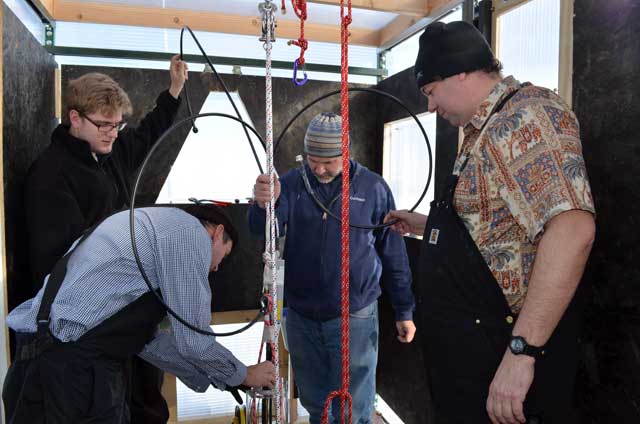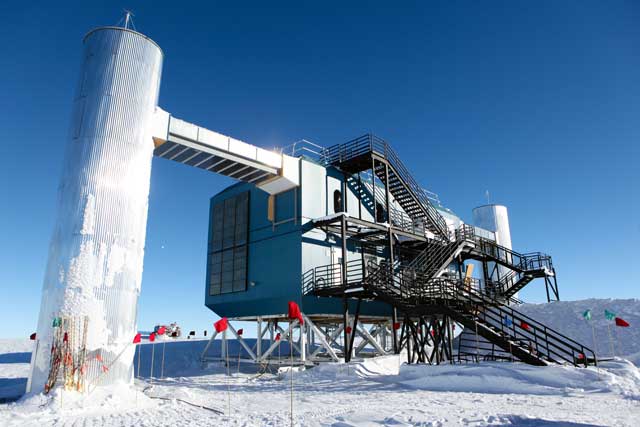|
A bigger mousetrapNew neutrino detector prototype at South Pole goes after highest energy particlesPosted November 8, 2013
To catch the elusive subatomic particles called neutrinos is not just a matter of building a better mousetrap. You need a really, really BIG mousetrap. Physicist Albrecht Karle Three of 37 proposed stations in the Askaryan Radio Array (ARA) 
Photo Credit: Peter Rejcek
The ARA team, led by Albrecht Karle, second from left, hook up the cables for one of the antennas in the array.
The South Pole is already home to the world’s biggest (to date) neutrino telescope. The IceCube Neutrino Observatory On the other hand, ARA will use radio antennae to detect equally brief radio pulses from neutrinos that originate outside the Milky Way Galaxy with energy ranges beyond what even IceCube can track. “The full array of 37 stations would have a sensitivity or discovery potential for these highest energy neutrinos 10 times better than IceCube – and IceCube is already the best experiment even at these energies. It’s quite amazing,” said Karle, a professor in the Department of Physics The array is named after Russian physicist Gurgen Askaryan who figured out that the cloud of secondary particles created in the interaction of high-energy neutrinos will create a burst of radio waves in a medium that is transparent to radio waves such as salt or ice. At high energies, these radio waves are detectable using radio antennae. “We use the ice as a target for interactions,” Karle explained. High-energy neutrinos result from violent events in the far-flung corners of the universe, such as exploding stars or by the formation of black holes. Physicists believe neutrinos contain clues about the origin of high-energy particles – cosmic rays – in the universe, thanks to the fact that they make a straight beeline through the universe without really changing course. “We will have good directional resolution, so we’ll see from where these events come,” Karle said. “These neutrinos would establish a very distinct correlation to the highest energy cosmic rays. These are the ones we are trying to discover.” How much punch do these cosmic rays carry? The particles hold about 10 million times more energy than can be produced by accelerators on Earth such as CERN’s Large Hadron Collider Karle said ARA could not only potentially establish the absolute flux of the so-called cosmogenic neutrinos, but could also determine whether the highest energy cosmic rays consist of just protons, iron nuclei, or both. “ARA has a real prospect to answer that question and measure the cosmogenic neutrino flux,” he said. Much work lies ahead before that happens. |



For USAP Participants |
For The Public |
For Researchers and EducatorsContact UsU.S. National Science FoundationOffice of Polar Programs Geosciences Directorate 2415 Eisenhower Avenue, Suite W7100 Alexandria, VA 22314 Sign up for the NSF Office of Polar Programs newsletter and events. Feedback Form |



